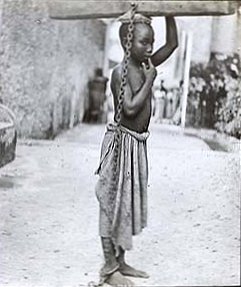- 1926 Slavery Convention
Infobox Treaty
name = 1926 Slavery Convention
long_name =

image_width = 200px
caption = Boy slave inZanzibar , c.1890
type =
date_drafted =
date_signed =25 September 1926
location_signed =Geneva
date_sealed =
date_effective =9 March 1927
condition_effective = Fulfilled
date_expiration =
signatories =
parties = 97 as at February 2002 [ [http://www.unhchr.ch/html/menu3/b/treaty3.htm Multilateral treaties deposited with the Secretary-General- TREATY I-XVIII-3.asp ] ] (Convention and subsequent Protocol)
depositor =
language =
languages =
website =
wikisource =The 1926 Slavery Convention or the Convention to Suppress the Slave Trade and Slavery was an
international treaty created under the auspices of theLeague of Nations and first signed onSeptember 25 ,1926 .Background
In the
Brussels Conference Act of 1890 the signatories "declared that they were equally animated by the firm intention of putting an end to the traffic inAfrican slaves ."In the Convention of
Saint-Germain-en-Laye of 1919, the signatories "affirmed their intention of securing the complete suppression of slavery in all its forms and of the slave trade by land and sea."A Temporary Slavery Commission was appointed by the Council of the
League of Nations in June 1924.Significance
With the 1926 Slavery Convention, concrete rules and articles were decided upon, and slavery and slave trade were banned.
Slavery was defined(Art.1) as:
"the status or condition of a person over whom any or all of the powers attaching to the right of ownership are exercised"
and the slave trade was defined to include:"all acts involved in the capture, acquisition or disposal of a person with intent to reduce him to slavery; all acts involved in the acquisition of a slave with a view to selling or exchanging him; all acts of disposal by
sale orexchange of a slave acquired with a view to being sold or exchanged, and, in general, every act of trade or transport in slaves."Contents (summarised)
Article 2
The parties agreed to prevent and suppress the slave trade and to progressively bring about the complete elimination of slavery in all its forms.
Article 6
The parties undertook to promulgate severe penalties for slave trading, slaveholding, and enslavement.Participants
As of 5 February 2002, 97 countries have signed, acceded to, ratified, or otherwise committed to participation in the Convention (as amended) and its subsequent Protocol. The countries and the year of their first commitment to participation (bracketed) are:
"Afghanistan "(1954)," Albania "(1957)," Algeria "(1963)," Australia "(1953)," Austria "(1954)," Azerbaijan "(1996)," Bahamas "(1976)," Bahrain "(1990)," Bangladesh "(1985)," Barbados "(1976)," Belarus "(1956)," Belgium "(1962)," Bolivia "(1983)," Bosnia and Herzegovina "(1993), " Brazil "(1966)," Cameroon "(1984)," Canada "(1953)," Chile "(1995)," Croatia "(1992)," Cuba "(1954)," Cyprus "(1986)," Denmark "(1954)," Dominica "(1994)," Ecuador "(1955)," Egypt "(1954)," Ethiopia "(1969)," Fiji "(1972)," Finland "(1954)," France "(1963)," Germany "(1973)," Greece "(1955)," Guatemala "(1983)," Guinea "(1963)," Hungary "(1958)," India "(1954)," Iraq "(1955)," Ireland "(1961)," Israel "(1955)," Italy "(1954)," Jamaica "(1964)," Jordan "(1959), " Kuwait (1963), Kyrgyzstan "(1997)," Lesotho (1974), Liberia (1953), Libya (1957), Madagascar (1964), Malawi "(1965)," Mali "(1973)," Malta "(1966)," Mauritania "(1986)," Mauritius "(1969)," Mexico "(1954)," Monaco "(1954)," Mongolia "(1968)," Morocco "(1959)," Myanmar "(1957)," Nepal "(1963)," Netherlands "(1955)," New Zealand "(1953)," Nicaragua "(1986)," Niger "(1964)," Nigeria "(1961)," Norway "(1957)," Pakistan "(1955)," Papua New Guinea "(1982)," Philippines "(1955)," Romania "(1957)," Russia "(1956)," St Lucia "(1990)," St Vincent and the Grenadines "(1981)," Saudi Arabia "(1973)," Sierra Leone (1962), Solomon Islands "(1981)," South Africa "(1953)," Spain "(1976)," Sri Lanka "(1958)," Sudan "(1957)," Sweden "(1954)," Switzerland "(1953)," Syria"(1954)," Taiwan "(1955)," Trinidad and Tobago "(1966)," Tunisia "(1966)," Turkey "(1955)," Turkmenistan "(1997)," Uganda "(1964)," Ukraine "(1959)," UK "(1953)," Tanzania "(1962)," USA "(1956)," Uruguay "(2001)," Viet Nam "(1956)," Yemen "(1987)," Yugoslavia "(2001)," Zambia "(1973)" "
Supplementations
The Convention was amended by the Protocol entering into force on 7 July 1955. [http://www.ohchr.org/english/law/slavery.htm]
The definition of slavery was further refined and extended by a 1956 Supplementary Convention.
See also
OHCHR - Office of the United Nations High Commissioner for RefugeesReferences
External links
* [http://www.unhchr.ch/html/menu3/b/f2sc.htm Convention text]
* [http://www.unhchr.ch/html/menu3/b/treaty3.htm List of parties/participants as at 5 February 2002]
Wikimedia Foundation. 2010.
